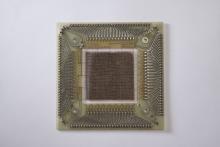
A plane of magnetic core memory with 64x64 bits (4Kb) as used in a CDC 6600. The very first CDC 6600 was delivered to CERN in 1965 and was the fastest supercomputer of its time.
Magnetic-core memory was the predominant form of random-access computer memory for 20 years (circa 1955–75). It uses tiny magnetic toroids (rings), the cores, through which copper wires were hand-threaded to write and read information.
Each core represents one bit of information. The cores can be magnetized in two different ways (clockwise or counterclockwise) and the bit stored in a core is zero or one depending on that core's magnetization direction.
The wires are arranged to allow an individual core to be set to either a "one" or a "zero", and for its magnetization to be changed, by sending appropriate electric current pulses through selected wires. The process of reading the core causes the core to be reset to a "zero", thus erasing it.
See also
http://cerncourier.com/cws/article/cern/29143/1/cerncnews5_9-04
